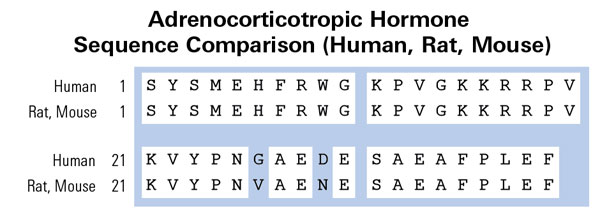Catalog # |
Size |
Price |
|
|---|---|---|---|
| 001-12 | 200 µg | $61 |
 )
)
|
Phe-Arg-Trp-Gly-Lys-Pro-Val-Gly-Lys-Lys-Arg-Arg-Pro-Val-Lys-Val-Tyr-Pro-Asn-Gly-Ala-Glu-Asp-Glu-Ser-Ala-Glu-Ala-Phe-Pro-Leu-Glu
|
| 3659.7 | |
|
| ≥ 95% |
|
| Exhibits correct molecular weight |
|
| Soluble in water |
|
|
Up to 6 months in lyophilized form at 0-5°C. For best results, rehydrate just before use. After rehydration, keep solution at +4°C for up to 5 days or freeze at -20°C for up to 3 months. Aliquot before freezing to avoid repeated freeze-thaw cycles. |
|
| White powder |
|
| Each vial contains 200 µg of NET peptide. |

We investigated the temporal alterations of adrenocorticotropic hormone (ACTH) immunoreactivity in the hippocampus after seizure onset. Expression of ACTH was observed within interneurons in the pre-seizure group of seizure sensitive gerbils, whereas its immunoreactivities were rarely detected in seizure resistant gerbil. Three hr after the seizure, ACTH immunoreactivity was significantly increased in interneurons within all hippocampal regions. On the basis of their localization and morphology through immunofluorescence staining, these cells were identified as GABAA α1-containing interneurons. At the 12 hr postictal period, ACTH expression in these regions was down-regulated, in a similar manner to the pre-seizure group of gerbils. These findings support the increase in ACTH synthesis that contributes to a reduction of corticotrophin-releasing factor via the negative feedback system which in turn provides an opportunity to enhance the excitability of GABAergic interneurons. Therefore, ACTH may play an important role in the reduction of excitotoxicity in all hippocampal regions.
Oh YJ, Kim HN, Jeong JH, et al. Altered expression of adrenocorticotropic hormone in the epileptic gerbil hippocampus following spontaneous seizure. BMB Rep. 2013;46(2):80-5.
Objective: To examine the factors causing inadequate cortisol responses to the 1 µg ACTH stimulation test. Design: Random test assignment (by age and gender) at 0800 or 1600 h.
Methods: We recruited 20 healthy adults to each of the three age groups (<40 years, 40-55 years, and >55 years; half females in each group). ACTH stimulation tests were performed in an outpatient clinic at the NIH Clinical Research Center. Plasma cortisol was measured just before, and 30 and 60 min after the administration of 1 mg ACTH (1-24). The ACTH concentration in diluted and administered solutions was measured.
Results: Twenty-five volunteers (19 at 1600 h) had a subnormal cortisol response (peak cortisol 10.4-17.5 µg/dl), using a criterion <18 mg/dl (497 nmol/l), for a specificity of 58% (confidence interval (CI) 45-71%). Afternoon testing had a significant impact on failure rates (odds ratio 6.98, CI 2.17-22.43), while gender and age did not. The stock solution contained 1 µg ACTH, but after administration through tubing it contained only 0.5-0.8 µg.
Conclusions: The high rate of abnormal results, especially in the afternoon, and loss of ACTH through tubing suggest that morning testing and minimal tubing should be adopted to avoid an inappropriate diagnosis of adrenal insufficiency. Earlier time points and standardized protocols would facilitate comparison of studies.
Wade M, Baid S, Calis K, Raff H, Sinaii N, Nieman L. Technical details influence the diagnostic accuracy of the 1 microg ACTH stimulation test. Eur J Endocrinol. 2010;162(1):109-13.
We investigated the central effect of ACTH 1-39 (ACTH) and peptides derived from the N-terminus (ACTH 1-10, Acetyl-ACTH 1-13-amide [alpha-MSH]) and C-terminus (ACTH 18-39 and ACTH 22-39) of this peptide on feeding in 16 hour-fasted or rats fed ad libitum. As expected, ACTH reduced feeding in fed and previously fasted rats, although this anorectic effect was more pronounced in fasted rats. The N-terminal-derived peptide alpha-MSH, but not ACTH 1-10, reduced cumulative food intake over 2 h after its injection intracerebroventricularly (icv) in 16 h-fasted, but not in fed rats. In contrast, the C-terminal fragments produced a long-lasting increase in feeding in fasted, but not in fed rats. The anorectic effects of N-terminal fragments of ACTH are recognised to be mediated via melanocortin MC4 receptors. However, the orexigenic effects of the C-terminal fragments do not appear to be conducted via MC4 receptors, since neither ACTH 18-39 nor ACTH 22-39 stimulated cAMP accumulation nor inhibited the ACTH-stimulated cAMP accumulation in HEK-293 cells transfected with the recombinant MC4 receptor.
Al-barazanji KA, Miller JE, Rice SQ, Arch JR, Chambers JK. C-terminal fragments of ACTH stimulate feeding in fasted rats. Horm Metab Res. 2001;33(8):480-5.
No References
| Catalog# | Product | Size | Price | Buy Now |
|---|
Social Network Confirmation